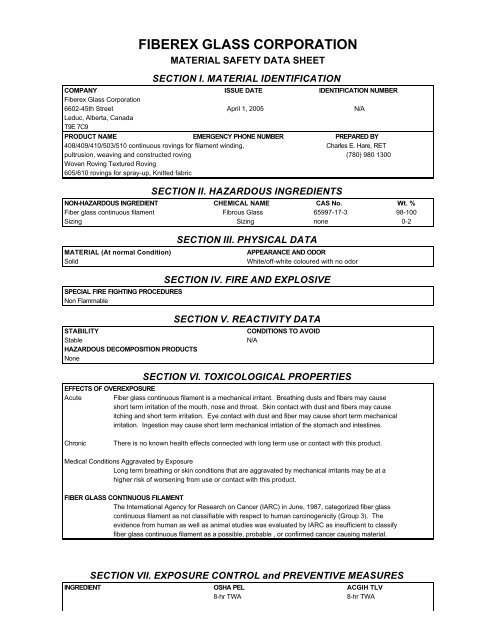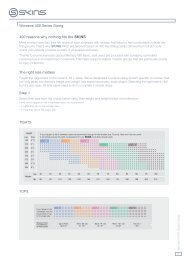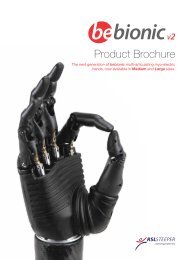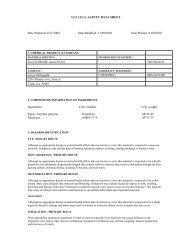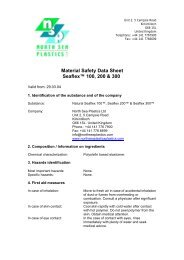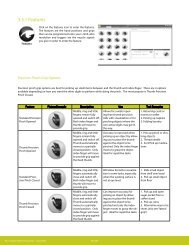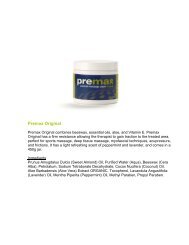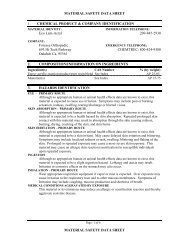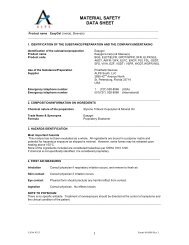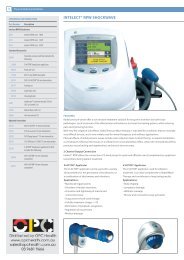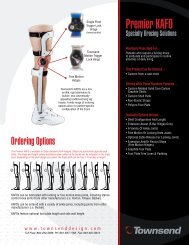Fibrex Glass MSDS - OPC Health
Fibrex Glass MSDS - OPC Health
Fibrex Glass MSDS - OPC Health
Create successful ePaper yourself
Turn your PDF publications into a flip-book with our unique Google optimized e-Paper software.
FIBEREX GLASS CORPORATIONMATERIAL SAFETY DATA SHEETSECTION I. MATERIAL IDENTIFICATIONCOMPANY ISSUE DATE IDENTIFICATION NUMBERFiberex <strong>Glass</strong> Corporation6602-45th Street April 1, 2005N/ALeduc, Alberta, CanadaT9E 7C9PRODUCT NAME EMERGENCY PHONE NUMBER PREPARED BY408/409/410/503/510 continuous rovings for filament winding, Charles E. Hare, RETpultrusion, weaving and constructed roving (780) 980 1300Woven Roving Textured Roving605/610 rovings for spray-up, Knitted fabricSECTION II. HAZARDOUS INGREDIENTSNON-HAZARDOUS INGREDIENT CHEMICAL NAME CAS No. Wt. %Fiber glass continuous filament Fibrous <strong>Glass</strong>65997-17-3 98-100Sizing Sizingnone 0-2MATERIAL (At normal Condition)SolidSECTION III. PHYSICAL DATAAPPEARANCE AND ODORWhite/off-white coloured with no odorSPECIAL FIRE FIGHTING PROCEDURESNon FlammableSTABILITYStableHAZARDOUS DECOMPOSITION PRODUCTSNoneSECTION IV. FIRE AND EXPLOSIVESECTION V. REACTIVITY DATACONDITIONS TO AVOIDN/ASECTION VI. TOXICOLOGICAL PROPERTIESEFFECTS OF OVEREXPOSUREAcute Fiber glass continuous filament is a mechanical irritant. Breathing dusts and fibers may causeshort term irritation of the mouth, nose and throat. Skin contact with dust and fibers may causeitching and short term irritation. Eye contact with dust and fiber may cause short term mechanicalirritation. Ingestion may cause short term mechanical irritation of the stomach and intestines.ChronicThere is no known health effects connected with long term use or contact with this product.Medical Conditions Aggravated by ExposureLong term breathing or skin conditions that are aggravated by mechanical irritants may be at ahigher risk of worsening from use or contact with this product.FIBER GLASS CONTINUOUS FILAMENTThe International Agency for Research on Cancer (IARC) in June, 1987, categorized fiber glasscontinuous filament as not classifiable with respect to human carcinogenicity (Group 3). Theevidence from human as well as animal studies was evaluated by IARC as insufficient to classifyfiber glass continuous filament as a possible, probable , or confirmed cancer causing material.SECTION VII. EXPOSURE CONTROL and PREVENTIVE MEASURESINGREDIENT OSHA PEL ACGIH TLV8-hr TWA8-hr TWA
Fiber glass continuous filament 5 mg/m3 5 mg/m3(respirable dust)1 fiber/cc15 mg/m3(total dust)1 fiber/cc(proposed)Size None established None establishedVentilationGeneral dilution ventilation and/or local exhaust ventilation should be provided as necessary tomaintain exposures below regulatory limitsPERSONAL PROTECTIONRespiratory A properly fitted NOISH/MSHA approved disposable dust respirator such as 3M model 8210(formerly 8710) or model 9900 (in high humidity environments) or equivalent should be used when:high dust levels are encountered; the level of glass fibers in the air exceeds the OSHA permissiblelimits; or if irritation occurs. Use respiratory protection in accordance with your company'srespiratory protection program, local regulations and OSHA regulations under 29 CFR 1910.134.SkinEyeLoose fitting long sleeved shirt that covers to the base of neck, long pants and gloves. Skinirritation is known to occur chiefly at pressure points such as around neck, wrist, waist andbetween fingers.Safety glasses, goggles or face shield.WORK AND HYGIENIC PRACTICESHandle using good industrial hygiene and safety practices. Avoid unnecessary contact with dustsand fibers by using good local exhaust ventilation. Remove material from the skin and eyes aftercontact. Remove material from clothing using vacuum equipment (never use compressed air andalways wash clothes separately from other clothing. Wipe out washer or sink to prevent loosefibers from getting on other clothing). Keep the work area clean of dusts and fibers made duringfabrication by using vacuum equipment to clean up dusts and fibers (avoid dry sweeping or usingcompressed air as these techniques re-suspend dusts and fibers in the air). Have access to safetyshowers and eye wash stations.InhalationEye ContactSkin ContactIngestionSECTION VIII. EMERGENCY AND FIRST AID PROCEDURESMove person to fresh air. Seek medical attention if irritation persistsFlush eyes with running water for at least 15 minutes. Seek medical attention if irritation persists.Wash with mild soap and running water. Use a washcloth to help remove fibers. To avoid moreirritation, do not rub or scratch effected area. Rubbing or scratching may force fibers into skin. Seekmedical attention if irritation persists.Ingestion of this material is unlikely. If it does occur, watch the person for several days to makesure that intestinal blockage does not occur.SECTION IX. PREPARATION DATE of <strong>MSDS</strong>.Prepared by Phone Number DateCharles E. Hare, RET (780) 980 1300 April, 2005


